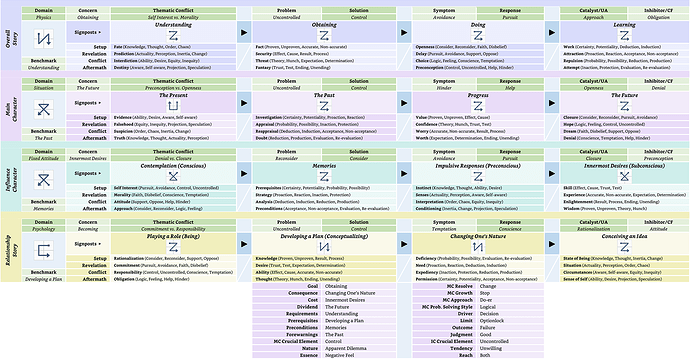The Table of Scenes originated long ago when the Dramatica Email List was running.
While I always found it to be useful, I’ve always personally preferred a more horizontal view of Story.
So, taking my inspiration from the good old Table of Scenes, I’ve come up with my own rendition of a Story Chart that I like to call the “Horizontal Story Progression.”
Here it is, using a story I’m working on as an example:
I created this in Microsoft word, and then exported it as a PDF file. If anyone would like the original (empty version) of the Word Document, just PM me with your email. I’ll have to send you the act order icons as well, if you want to use those in your own document.
I prefer a mix of new and old Dramatica terminology, but you can use whatever you like. I also include the element level information for the Variations, though you don’t have to. I mainly use them as a way to learn more about Dramatica. I hope to one day have the entire Dramatica model memorized.
I aso use little helper texts to remind me of the new and old terminology, so I can learn to use tthem interchangeably.
I prefer this to the table of scenes because it is a horizontal progression that might fit better on individual index cards. I had to create the document on tabloid-size paper (17 x 11 Landscape) in order to fit everything, so you may not be able to print your own version on regular size paper unless your printer or printing software allow for some kind of scaling to fit standard paper sizes.
If you’d find this useful, let me know!
Rod
Edit: If one were to take the individual throughlines, divide them up just after each of the journey arrows, the information would probably fit well on index cards. You don’t have to include all the information I did, or use the Throughline order that I did. LIke I said, I just use this as a way to get to know my story as well as gaining a clearer understanding of Dramatica itself and how all the pieces interact with each other.
I also included diagonal white lines that go from a sequence’s Aftermath to the next sequence’s Setup, as I read somewhere that the Outcome of a particular sequence can be used to fuel the Setup of the next, etc.


